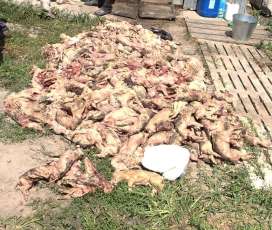|
|

機器人翻譯中文:
由英國動物和植物衛生局(APHA)的一份報告證實,高致病性豬流行性腹瀉病毒(PEDV)是在烏克蘭養豬場確實存在。
該報告將由APHA和英國豬獸醫學會(PVS)短期內公開,但已經分享了豬進度提前公佈。
這是第一次正式的實驗報告發表在確認烏克蘭株確實高致病性豬流行性腹瀉病毒。已確定的應變適合於完全符合2011年和2012年發現於美國在2013年和2014年,以及中國的病毒株,這是這種病毒在歐洲的第一次分離。
該報告說,與最近從美國和墨西哥*報導菌株“的高達99.8%,全基因組核苷酸相似性”的。
顧問
應變研究在英國,英國之後,獸醫顧問醫生約翰·凱爾曾懷疑豬流行性腹瀉病毒在烏克蘭的存在。卡爾參觀了三個農場中旬烏克蘭去年夏天,他公認的臨床體徵,因為他們是非常相似的新的中國/美國株引起在亞洲和北美的農場問題。
有他的懷疑證實在當地被證明是困難的,因為正確的技術來通過序列分析,確定該病毒是在烏克蘭的一個艱鉅的任務,卡爾告訴博主哈利西門子早在十一月。
謠言
自2014年開始的豬流行性腹瀉病毒存在於烏克蘭的傳言已經出現,一些消息來源報導,豬進展。十二月初,外國農業局(FAS),農業部設在基輔美國農業部(USDA)的一部分,正式發出了有關情況GAIN報告。
在這份報告中,FAS指出:“FAS /基輔也一直在與最大的養豬生產者協會的聯繫,烏克蘭的豬育種(SB),並發現SB成員報告了三到四種情況PED今年“。
作者亞歷山大Tarassevych,FAS,對豬的進展的報告的主要來源之一是最近的一篇文章由獸醫博士維克多·埃弗特,碩騰烏克蘭。
Unclarity
病毒的序列,而不是已經公開了科學實驗室確診導致一種情況,即在實際健康狀況是彌補任何人的解釋。烏克蘭官方消息,像烏克蘭(APPU)和烏克蘭的獸醫和植物衛生服務的養豬生產者協會Derzhvetfitosluzhba至今既沒有證實也沒有否認豬流行性腹瀉病毒在該國爆發。
然而,預計的是,烏克蘭獸醫和植物衛生服務將使下週的課程的正式反應。
此外,APPU,被稱為“SB”的對外農業服務在其報告中指出,其成員都沒有給出任何關於豬流行性腹瀉病毒疫情信息的對外農業服務。
問題
的應變確認導致烏克蘭的幾個問題。來源指向的問題,這可能是值得要問它怎麼可能才剛剛幾起案件已被確認,而在美國數以百萬計的豬在任何時間已經死了?
此外,到目前為止,還沒有明顯的變化已經感覺到豬在烏克蘭的號碼 - 1.6%,只是略微下降,可以很容易地作為一個季節性效應解釋。
此外,百萬美元的問題是沒如何病毒進入烏克蘭?
探訪
在此期間,卡爾博士還總結了三個農場,他參觀了他的一個發現。在這個農場,一個5000頭母豬單位,農場達到幾乎100%的死亡率之間仔豬可達年齡10天-也看到了圖片。總共30000仔豬丟失。他的發現和觀點的更詳細的報告可以讀的即將發行豬進展雜誌。在所有這三個農場的情況現在回爆發前,他說,但花了近20週的恢復農場。
獸醫顧問深感擔憂的確認。在看到豬流行性腹瀉病毒在亞洲和北美的影響,他是怕病毒會影響生產,在整個歐洲大陸,在幾個月來 - 並指向3500萬潛在的仔豬死亡人數在今後18個月。
豬流行性腹瀉病毒在歐洲的
烏克蘭應變不應混淆與農場豬流行性腹瀉病毒確認在其他幾個國家在歐盟,如荷蘭和德國。這裡出現的病毒是傳統的溫和的壓力。
*這些菌株分別被稱為美國/ Kansas29 / 2013(GenBank登錄號KJ645637.1)和美國/ Colorado30 / 2013(GenBank登錄號KJ645638.1)。
底下為原文:
UK lab confirms PEDv outbreaks in Ukraine
0646HEALTH / DISEASES
A report by the British Animal & Plant Health Agency (APHA) has confirmed that highly pathogenic Porcine Epidemic Diarrhoea virus (PEDv) is indeed present on pig farms in Ukraine.
The report will be made public shortly by APHA and the British Pig Veterinary Society (PVS) but has been shared with Pig Progress ahead of publication.
It is the first time an official laboratory report is published confirming that strains from Ukraine are indeed the highly virulent PEDv. The identified strain fits in perfectly with strains of the virus discovered in the United States in 2013 and 2014 as well as China in 2011 and 2012. This is the first isolation of this virus in Europe.
The report speaks of a 'full genome nucleotide similarity of up to 99.8%' with the strains recently reported from the United States and Mexico*.
Consultant
The strain was investigated in the United Kingdom, after British veterinary consultant Dr John Carr had suspected the presence of PEDv in Ukraine. Carr visited three farms in mid-Ukraine in summer last year and he recognised clinical signs as they were very similar to the new Chinese/US strains causing problems on farms in Asia and North America.
Having his suspicions confirmed locally proved to be difficult, as the right technology to identify the virus by sequence analysis was a difficult task in Ukraine, Carr told blogger Harry Siemens back in November.
Rumours
Rumours of PEDv being present in Ukraine have been around since the beginning of 2014, several sources have reported to Pig Progress. Early December, the Foreign Agricultural Service (FAS), a part of the United States Department of Agriculture (USDA) located in Kyiv, officially sent out a GAIN report about the situation.
In this report, the FAS states: "FAS/Kyiv has also been in contact with the largest swine producer association, the Swine Breeders of Ukraine (SB), and discovered that SB members have reported three-to-four cases of PED this year."
Author Alexander Tarassevych, FAS, told Pig Progress that one of the major sources of the report is a recent article by veterinarian Dr Victor Evert, Zoetis Ukraine.
Unclarity
The virus sequence, not having been publicly confirmed by scientific laboratories led to a situation in which the factual health situation was up for anybody's interpretation. Ukrainian official sources, like the Association of Pig Producers of Ukraine (APPU) and the Ukraine's veterinary and phytosanitary service Derzhvetfitosluzhba so far have neither confirmed nor denied an outbreak of PEDv in the country.
It is expected, however, that the Ukrainian veterinary and phytosanitary service will give an official reaction in the course of next week.
In addition, the APPU, referred to as 'SB' by the Foreign Agricultural Service in its report, states that its members have not given any information to the Foreign Agricultural Service about PEDv outbreaks.
Questions
The confirmation of the strain leads to several questions in Ukraine. Sources point to the question that it might be worthwhile to ask how is it possible that only just several cases have been confirmed while in the US millions of pigs had died in no-time?
In addition, so far no noticeable changes have been felt on the numbers of pigs in Ukraine – just a slight decrease of 1.6% which can easily be explained as being a seasonal effect.
Apart from that, the million dollar question is how did it the virus get into the Ukraine?
Visits
In the meantime, Dr Carr also summarised his findings on one of the three farms he visited. On this farm, a 5,000 sow unit, the farm reached an almost 100% mortality amongst piglets up to ten days of age – see also the picture. In total, 30,000 piglets were lost. A more detailed report of his findings and views can be read in the upcoming issue of Pig Progress magazine. On all three farms the situation is now back to before the outbreaks, he says, but it took nearly 20 weeks for the farms to recover.
The veterinary consultant is deeply worried about the confirmation. Having seen the impact of PEDv in Asia and North America, he is afraid the virus will impact the production in the entire European continent in the months to come – and points to numbers of 35 million potential dead piglets over the next 18 months.
PEDv in Europe
The strain in Ukraine should not be confused with PEDv confirmations on farms in several other countries in the European Union, like the Netherlands and Germany. Here the virus appears to be the traditional mild strain.
* These strains are known respectively as USA/Kansas29/2013 (GenBank accession no. KJ645637.1) and USA/Colorado30/2013 (GenBank accession no. KJ645638.1).
引用來源
|
|